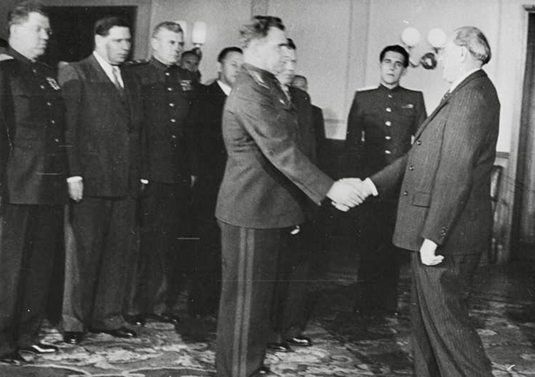On the Marshal’s Desk, Part 3
- Maria A. Kithcart

- Sep 25, 2024
- 3 min read
Updated: Jul 4

Pictured: Colonel-General V.I. Chuikov (left) talking with Marshal K.K. Rokossovsky, 1945. General Chuikov’s brother Nikolai Ivanovich is also shown in the photograph (in between Vasily Ivanovich and Rokossovsky, facing forward); Marshal Chuikov’s desk items in the Museum of the Cadet Corps of the Investigative Committee of Russia in Volgograd (Rokossovsky’s book inscribed to Chuikov is circled in yellow); an autographed edition of The Great Victory on the Volga, signed by Marshal Rokossovsky on 15 May 1965.
In earlier posts, I examined photos of items on Marshal Chuikov’s desk to offer insights into his life and work (see Part 1 and Part 2 of this series). This latest entry explores a book inscribed to him from editor Marshal K.K. Rokossovsky—a volume which covers the entire Battle for Stalingrad in two parts. It was published with a separate album which contains a collection of 29 maps depicting the positions of the German and Soviet armies.

Marshal Chuikov's inscribed book from Marshal Rokossovsky
Often referred to as the Red Army’s “gentleman commander,” Marshal Rokossovsky was a pivotal figure in major battles of the Eastern Front, including the Battle of Moscow, the Battle for Stalingrad (in command of the Don Front during Operation Uranus), the Battle of Kursk, and the liberation of Belarus during Operation Bagration. Rokossovsky was known for his calm, disciplined leadership and ability to orchestrate complex operations, earning him respect from both his peers and subordinates.
Regarding his comrade, Rokossovsky wrote the following in his memoir titled A Soldier’s Duty:
"It was especially hard for the troops holding the Magnushevsky bridgehead [in Poland – MK]. I must say frankly that we managed to defend it to a large extent because the defense was led by the commander of the 8th Guards Army, Vasily Ivanovich Chuikov. He was there the whole time, in the thick of it." (290-291)

Another view of Marshal Chuikov's desk with Rokossovsky's signed book.
In his memoir titled The Fall of Berlin, Marshal Chuikov shared about a time when Marshal Rokossovsky deflected undue critique on his behalf. Before the Lublin-Brest Offensive beginning 18 July 1944, armies of the 1st Belorussian Front had been preparing for this segment of Operation Bagration in a push to cross the Bug River and drive back German forces. Crossing the Bug, the river flowing along the borders of Ukraine, Belarus, and Poland, was necessary to reach another objective, the eastern bank of the Vistula River in Poland. Chuikov wrote the following account of this event:
“A rehearsal of the forthcoming operation was held twenty-four hours before it was due to start in fact, in order to check that coordination had been properly worked out. […] The course of this exercise assured me that those in command of our corps, divisions, and branches of the service had a correct understanding of what was new in the organization of this advance. They did not accept ready-made, textbook answers either in attack or in defense and looked for themselves for the tactical techniques. Regrettably, some of the visitors from higher commands did not comprehend the new features of the operation then due to commence. ‘Why is your Army making its advance faster than the Front command planned for?’ one of the guests asked me. I replied correctly but thought to myself that our idea did not please the vanity of this higher staff officer, who tried to make ‘improvements’ without having the new knowledge which the troops had won in battle.
Fortunately, K. K. Rokossovsky, the Front commander, came to my aid; he announced, loudly enough for all to hear, ‘You’re in command of the Army, you decide—and you will answer for all that is good or bad.’ That suited me very nicely.”
The connection between Marshals Chuikov and Rokossovsky is one of mutual respect and shared battlefield experiences, as reflected in the personal items and memoirs they left behind. Rokossovsky’s gift to Chuikov, a book of maps from the Battle of Stalingrad, symbolizes not only their roles in that pivotal conflict but also the enduring bond between two of the Red Army’s most influential commanders. Their shared leadership during key battles like Stalingrad and the Lublin-Brest Offensive reveals the deep trust and admiration they had for one another. Through these personal anecdotes and historical artifacts, we gain a deeper understanding of the men behind the military titles, their strategies, and the profound impact they had on the course of World War II.



